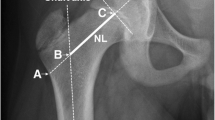Summary
A prospective study of femoral shaft fractures in children under the age of 14 years has been carried out in 71 patients who were reviewed both clinically and radiographically at yearly intervals. The processing of data has been carried out by univariate and multivariate analysis.
Femoral overgrowth (F.O.) averaged 8.63 mm (range 1–21 mm), and was found to be influenced by age (greater overgrowth in children between 3 and 9 years), the initial displacement of the fracture (greater overgrowth in severely displaced fractures), and overriding of the fragments at the time of healing (the greater the overriding the lesser the overgrowth). Consideration of these factors allowed overgrowth to be predicted from the time of fracture. Overgrowth occurred in all children over 2 years of age, and took place mainly during the first year after the fracture. It continued, although to a lesser extent, during the second year, and for as long as the fifth year in 27%. After this time the growth rate of both femurs was equal in all the children. Ipsilateral tibial overgrowth was present in only 60% of the children and averaged 1.05 mm (1–5 mm).
Résumé
Les auteurs ont réalisé une étude prospective des fractures de la diaphyse fémorale chez les enfants de moins de 14 ans. Elle a porté sur 71 patients qui ont été revus cliniquement et radiologiquement à intervalles d'un an. Les données recueillies ont fait l'objet d'analyses uni- et multivariantes.
L'hyperallongement du fémur a atteint 8,63 mm en moyenne (de 1 à 21 mm). Il est influencé par l'âge (il est plus important chez les enfants de 3 à 9 ans), par le déplacement initial (il est plus marqué dans les fractures à grand déplacement), et par le chevauchement des fragments lors de la consolidation (l'importance de l'allongement varie en raison inverse de celle du chevauchement). La connaissance de ces facteurs permet de prévoir le degré d'hyperallongement au moment même de la fracture. Cet allongement survient chez tous les enfants de plus de 2 ans, et surtout pendant la première année d'évolution. Il se poursuit, mais plus lentement, pendant la deuxième année et même jusqu'à la cinquième année dans 27% des cas. Ensuite, chez tous les enfants, les deux fémurs continuent à croître de façon égale. L'allongement du tibia homolatéral n'a été observé que chez 60% des enfants, il était en moyenne de 1,05 mm (de 1 à 5 mm).
Similar content being viewed by others
References
Allen BL, Kant AP, Emery FE (1977) Displaced fractures of the femoral diaphysis in children. J Trauma 17: 8–19
Barfod B, Christensen J (1958) Fractures of the femoral shaft in children with special reference to subsequent overgrowth. Acta Clin Scand 116: 235–250
Benum P, Ertresvag K, Hoiseth K (1979) Torsion deformities after traction treatment of femoral fractures in children. Acta Orthop Scand 50: 87–91
Blount WP, Schaefer AA, Fox GW (1944) Fractures of the femur in children. South Med J 37: 481–493
Brouwer KJ (1981) Torsional deformities after fractures of femoral shaft in childhood. Acta Orthop Scand [Suppl 195] Vol 52
Bryant E, Gillings D (1985) Statistical analysis of longitudinal repeated measures designs. In Sen PK: Biostatistics. Statistics in Biomedical, Public Health and Environmental Sciences. Elsevier Science Publishers BV (North-Holland)
Dameron TB, Tompson HA (1959) Femoral shaft fractures in children. J Bone Joint Surg 41A: 1.201–1.212
Edvarsen P, Syversen SM (1976) Overgrowth of the femur after fracture of the shaft in childhood. J Bone Joint Surg [58B: 339–342
Green WP, Wyat GM (1946) Orthoroentgenography as a method of measuring of bones of the lower extremities. J Bone Joint Surg 28: 60–65
Greiff J, Bergmann F (1980) Growth disturbance following fracture of the tibia in children. Acta Orthop Scand 51: 315–320
Greville NR, Ivins JC (1957) Fractures of the femur in children: an analysis of their effect on the subsequent length of both bones of the lower limb. Am J Surg 93: 376–384
Griffin PP, Anderson M, Green WT (1972) Fractures of the shaft of the femur in children. Orthop Clin Northam 3: 213–223
Hedström O (1969) Growth stimulation of long bones after fracture or similar trauma. Acta Orthop Scand [Suppl] 122, Vol 40
Humberger FW, Eyring EJ (1969) Proximal tibial 90-90 traction in treatment of children with femoral-shaft fractures. J Bone Joint Surg 51A: 499–504
Irani RN, Nicholson JT, Chung SMK (1976): Long-term results in the treatment of femoral-shaft fractures in young children by immediate spica immobilization. J Bone Joint Surg 58A: 945–951
Laer LW, Herzog B (1978): Beinlängendifferenzen und Rotationsfehler nach Oberschenkelschaftfrakturen im Kindesalter. Therapeutische Beeinflussung und Spontane Korrektur. Hel Chir Acta, 45: 17–21
Meals RA (1979) Overgrowth of the femur following fractures in children: Influence of handedness. J Bone Joint Surg 61A: 381–384
Montero M (1982): Dismetrias postfracturarias de la diafisis del fémur en niños. Rev Esp Cir Osteoar 17: 349–374
Neer CS, Cadman EF (1957) Treatment of fractures of the femoral shaft in children. JAMA, 163: 634–637
Reynolds DA (1981) Growth changes in fractured long bones. J Bone Joint Surg 63B: 83–88
Ryan JR (1981) 90-90 skeletal femoral traction for femoral shaft fractures in children. J Trauma 21: 46–48
Shapiro F (1981) Fractures of the femoral shaft in children. Acta Orthop Scand 52: 649–655
Staheli LT (1967) Femoral and tibial growth following femoral shaft fracture in childhood. Clin Orthop 55: 159–163
Truesdell ED (1921) Inequality of the lower extremities following fractures of the shaft of the femur in children. Ann Surg 74: 498–500
Viljanto J, Kiviluoto H, Paananen M (1975) Remodelling after femoral shaft fractures in children. Acta Chir Scand 141: 360–365
Weber BG (1969): Fractures of the femoral shaft in childhood. Injury 1: 65–68
Author information
Authors and Affiliations
Rights and permissions
About this article
Cite this article
Martin-Ferrero, M.A., Sanchez-Martin, M.M. Prediction of overgrowth in femoral shaft fractures in children. International Orthopaedics 10, 89–93 (1986). https://doi.org/10.1007/BF00267747
Published:
Issue Date:
DOI: https://doi.org/10.1007/BF00267747




